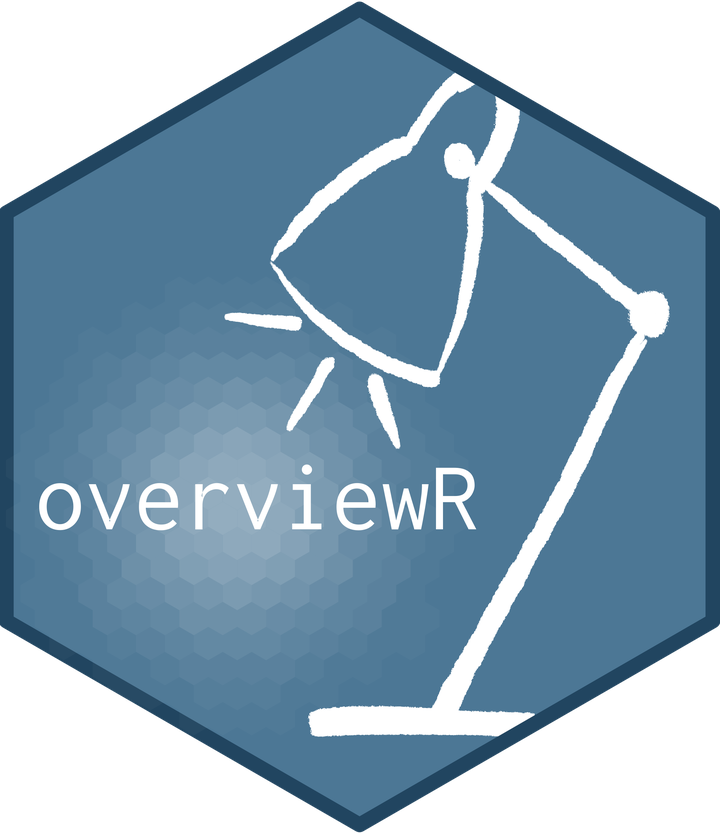overviewR
An R package to easily extract relevant information from your data

build with: ♥ | R | tidyverse | Travis CI | devtools | pkgdown
What is overviewR?
overviewR is a small yet powerful package that helps you to get an overview – hence, the name – of your data with particular emphasis on the extent that your distinct units of observation are covered for the entire time frame of your data set.
Why did we build it?
If you have a (large) data set that has many different observations over a long period, it becomes increasingly difficult to identify for each unique observation its exact coverage in the data. In particular, if some observations are not included for the entire time span of the data – either because they entered later, dropped out earlier or have gaps in between – it can become difficult to spot potential problems in your data’s time and scope.
overviewR allows you to quickly get a glimpse of your data and the distribution of your observations over time. With its ability to produce both data.frame objects and LaTeX/.tex outputs, it can be used by practitioners and academics alike.
How can it be used?
overviewR can be used by everyone who works with data that has a time-and-scope characteristic. That is, all data that contains different units of observation over a specific period will benefit from overviewR. To get a quick overview of which units – think countries, companies, test persons, etc. – are present or missing during a given time span – think of years, months, days, minutes, etc. – overviewR provides an easy and intuitive insight into the set-up of your data.
Consider a data set that covers countries over the past 50 years. Not all countries existed throughout the entire period – some dissolved, others were newly founded and yet for others, data might not be available for the entire period. Before starting any analysis, it might be helpful to get an overview not only of which countries are included and what the entire time span is but to see which countries are present at which points in time. In other words, are there missing data for certain countries at different points in time?
To get a quick and intuitive overview of your data, overviewR provides currently six basic functions:
overview_tabgenerates a basic table that lists all unique units of observation (e.g., countries) and aggregates the time frame when each unit is present in the data set. This means it also takes into account gaps in the data set, e.g., when there is – for whatever reason – no data available for a country for a few years within the time frameoverview_crosstabgenerates a similar table but allows you to separate the overview table using two conditions. For instance, you want to know not only at what time points countries are present in your data but also when these countries can be considered to have high or low GDP and can be categorized as having a small or large population size. For this, overview_crosstab is used.overview_printtakes a table – either generated byoverview_taboroverview_crosstaband turns it into a LaTeX output. It even allows you to save the LaTeX output in a ready-to-use .tex file.overview_plotvisualizes the time and scope conditions of your data in a ggplot plot. For each scope object in your data (e.g., countries) on the y-axis, it plots the time coverage (x-axis) as a horizontal line for all time points in your data. This helps to spot gaps in your data for specific scope objects or simply creates a graphical display of your time and scope conditions and can be a good companion for presentation slides or appendices.overview_heatvisualizes the coverage of each time and scope combination of your dataset in a heat map style ggplot. Each cell in the heat map is colored based on the coverage of a scope object at a given time point. Additionally, it displays either the total number of cases covered or a relative percentage as plain text. This helps to spot missing information even more nuanced. For instance, in a monthly data set with countries as the scope object, it illustrates the percentage of covered months in the data for each country-year combination.overview_nagraphically illustrates the total number of NAs across all variables in your data set as a horizontal bar plot. Similar to the other plot objects,overview_nareturns a ggplot object and can be modified and adjusted accordingly.
How to use these functions is best explained in the Getting Started section.